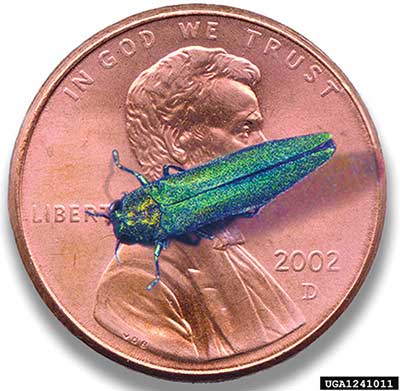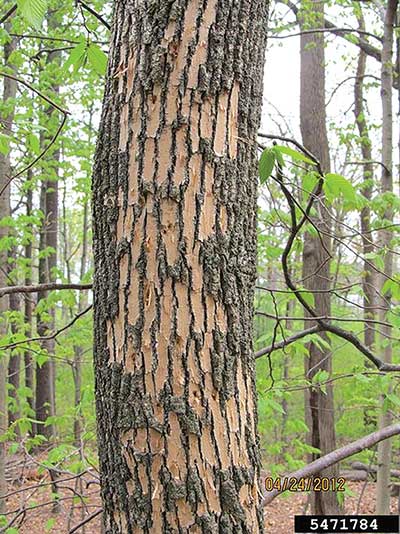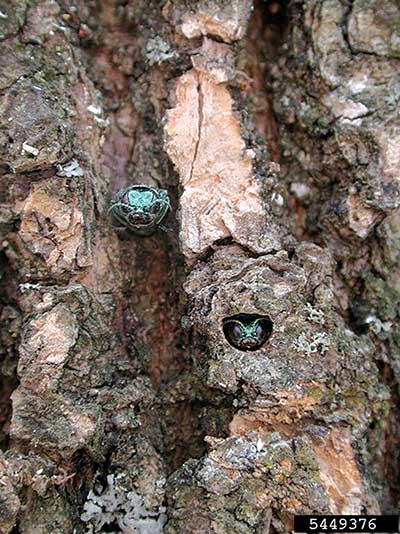 |
| Emerald ash borer shown on a penny for size comparison. Photo by Howard Russell, Michigan State University, Bugwood.org, from https://www.invasive.org/browse/detail.cfm?imgnum=1241011. Licensed under a Creative Commons Attribution 3.0 License |
 |
| Flecked bark resulting from woodpecker feeding on emerald ash borers. Photo by Kenneth R. Law, USDA APHIS PPQ, Bugwood.org, from https://www.invasive.org/browse/detail.cfm?imgnum=5471784. Licensed under a Creative Commons Attribution 3.0 License. |
 |
| Emerald ash borer before it emerges from the tree. Photo by Debbie Miller, USDA Forest Service, Bugwood.org, from https://www.invasive.org/browse/detail.cfm?imgnum=5449376. Licensed under a Creative Commons Attribution-Noncommercial 3.0 License. |
By Hannah Murray, Low-impact Forestry Specialist, MOFGA
By now you have likely heard about a new arrival in town: the emerald ash borer (EAB), a non-native beetle that has been munching its way through the nation’s ash trees (Fraxinus species). It was first detected in Maine in June 2018 with an infestation in northern Aroostook County (along the border with Quebec), followed by detection in western York County (along the New Hampshire border) last fall. What does its arrival mean for the fate of Maine’s 100 million native ash trees? Here are some answers to common questions, plus resources to help you decide what to do with the ash in your backyard.
Is it as bad as they say it is?
In a word, yes. Since its first detection in 2002, this little beetle has spread from Michigan to 35 states and five Canadian provinces. It has managed to kill 100 percent of ash trees greater than 2 inches in diameter in southeast Michigan, and research predicts that less than 1 percent of ash trees nationwide will survive the infestation. The pest attacks trees large and small, healthy and stressed, and on all kinds of sites. Ash is central to Native American identity and culture, and its loss would devastate Wabanaki artisans who rely on the tree for basket-making. (See https://downeast.com/last-stand/)
How did it get here?
Native to East Asia, the beetle most likely hitched a ride to the United States in wooden packing material in cargo ships. Left to its own devices, it tends to fly half a mile (and no more than 2 miles) per year. Humans have unknowingly facilitated its spread, through transport of firewood, nursery stock and ash logs. So please tell Uncle Frank to leave behind his firewood when he visits this summer. Insist!
How can I tell if my trees are affected? What are the warning signs?
Between December and April, check to see if woodpeckers are feeding on your ash trees. Woodpeckers have been seen to work on healthy ash trees only when EAB is present. To get to the insect, the birds scrape off the outer bark, leaving a pattern of flecked, light-colored patches. (Note: Pileated woodpeckers and sapsuckers do not feed on EAB.) Visible signs of attack include dying branches at the top (upper crown) of the tree, vertical bark splitting, and epicormic branching (shoots growing from dormant buds on the trunk or branches). Harder to see are the S-shaped galleries beneath the bark and the D-shaped holes through which the insects emerge in May and early June. In Maine you won’t see the beetles during their non-flight season (October 1 to May 1), but you may spot them between June and August. The resources at the end of this article offer detailed photos and identification guides.
What timeframe are we talking about?
Damage to ash trees may not appear for up to three years after the insect has arrived. Infested trees die within three to five years, with sawlog quality decreasing after dieback of one-third of the crown, and sapwood discoloration after crown dieback reaches 50 percent. Trees killed by EAB quickly become brittle, weak and prone to snapping. They must be harvested immediately to have any chance of being salvaged as forest products.
In that case, should I cut down all my ash trees right now?
It depends on your proximity to the infested area, which you can find on the maps at www.maine.gov/eab. If you live within 10 miles of a known infestation, plan for EAB’s arrival and act quickly if you hope to salvage any ash on your property. Your local district forester (Maine Forest Service) can answer questions, provide resources and help identify a licensed consulting forester to assist you further.
If you live more than 10 miles from a known infestation, time is on your side – possibly years – but be ready with a plan for EAB’s eventual arrival. Know how much ash is on your property and its location, size and quality so that you know what is at stake.
The Maine Forest Service Information Sheets 28 and 29 offer detailed management options and recommendations based on your goals and the size of your trees. Even if you decide to harvest, the forest service recommends leaving scattered and small-diameter ash to provide genetic diversity and slow EAB’s spread. When planning, remember, “Management should focus on creating a more diverse forest in both structure and species composition, not eliminating ash.” (Info Sheet 29: EAB Guidance for Maine Forest Managers)
What should I do if I suspect EAB is on my property? My ash trees don’t look good.
Report it to www.maine.gov/eab or to the national EAB hotline at 1-866-322-4512. Note your observations, take photos and collect any insect samples. Remember that ash have been in decline in Maine for the past few years for reasons unrelated to EAB. Many of the symptoms are similar, and differentiating the source of the decline can be difficult.
I want to know with certainty whether EAB is causing the decline of ash on my property.
The only way to know whether EAB is the culprit is by girdling an ash tree in the spring. The stressed tree will act as a trap to attract EAB and, come winter, you can peel the bark to look for signs of infestation. Research has shown that girdled tree plots are the most effective strategy in slowing the arrival and minimizing the impact of EAB. The Maine Forest Service’s girdled trap tree program welcomes landowner participation ([email protected] or 207-287-2431). Spring is the time to girdle, so reach out soon if you hope to participate this year.
Is there any hope at all?
Despite the grim picture, there are some rays of hope. Infestation is far from widespread in Maine, and we may still have time to slow EAB spread – especially if we can halt the transport of firewood! For biological controls, woodpeckers may be able to cause more than 90 percent mortality in EAB. Scientists are exploring the use of parasitoid wasps and predators to reduce pest populations, and even heavily-infested areas have occasional surviving trees. White ash seems to be faring better than others and may have genetic resistance to EAB. Some municipalities have used pesticides to save target trees, with varying outcomes. Use of such chemicals may harm pollinators.
Where can I find out more?
The Emerald Ash Borer Information Network has maps, planning simulators, cost calculators, photos of infestation symptoms and extensive information on EAB lifecycles, as well as information about identifying ash trees and distinguishing EAB from lookalikes such as the native tiger beetle. You can follow the network on Twitter @emeraldashborer. The Maine Forest Service’s thorough EAB resource page also includes management recommendations, information on quarantine orders and public meetings, report forms (for submitting photos or specimens) and more.
Resources
Emerald Ash Borer: Information for Maine Landowners (Info Sheet 28)
Emerald Ash Borer: Guidance for Maine Forest Managers (Info Sheet 29)
Emerald Ash Borer: Strategies for Conserving Ash in the Urban Forest (TREE Fund webinar, December 5, 2018)

